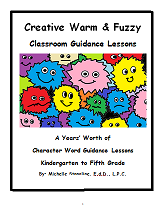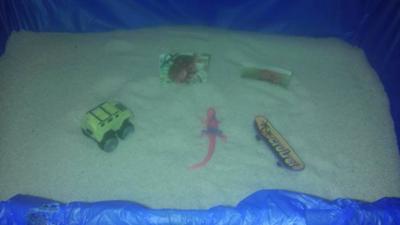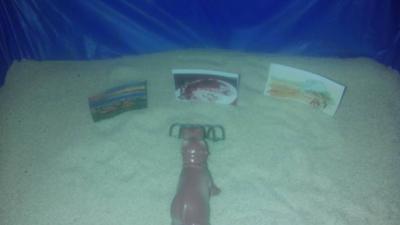Sand Tray Therapy Final Exam by Student #10
(Sand Tray Therapy Class Student)
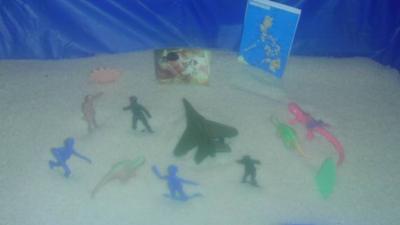
Sand Tray Therapy Final Exam by Student #10: Picture One
Sand Tray therapy is a therapeutic tool that can be incorporated and utilized in conjunction with talk therapy and other interventions. According to Taylor (2009), sand is recognizable regardless of age, gender, or ethnicity and utilizing sand in addition with miniatures one can move through the past, present, and future. Sand tray therapy as a whole can be effective with various types of populations.
My sand tray therapy theory seeks to address identity and feelings of disconnection from culture and family. Taking into consideration the history of the United States, the cultural makeup of this country, and the history of how various group either came or were brought into the United States, individuals may feel disconnected from their culture and family which affects their identity as a whole. Individuals may feel a lack of identity and lost and displaced within their family and as a whole from the feeling of knowing who he/she really is. It is beneficial for individuals to feel a sense of connection and a lack of connection may contribute to feelings of isolation and contribute to depression.
This is relevant across many cultural groups in the United States. With African Americans, many of their ancestors were brought over to the United States through slavery and many are unaware and unable to trace back their historical roots due to limited information within families, incomplete census data, information passed along orally which may be incorrect, and other factors. For some groups, when their ancestors immigrated to the United States, surnames were changed which also creates difficulty when seeking information about family origins.
My sand tray theory seeks for individuals to reconnect and gain connection with their culture and gain acceptance and understanding of themselves. Feeling a sense of connection may contribute to individuals gaining a greater sense of themselves and their culture which may lead to higher esteem about the self and cultural group. Many individuals may feel invisible, endangered of being lost and insignificant as if he/she does not matter or his/her feelings are unimportant.
My theory can be applied and utilized among Filipino Americans. My sand tray theory seeks to allow clients to feel visible, special, and significant through various symbols: The Chocolate Hills and a map of the Philippines, the Philippine Flag, and other symbols. The flag has a golden yellow sun with eight primary rays, which represent the country's first group of provinces that started the 1896 Philippine Revolution against Spain; and at each vertex of the triangle is a five-pointed golden yellow star, each of which represents the country's 3 main regions - Luzon, Visayas and Mindanao (Wikipedia, 2012).
Lesson Plan #1 Gaining Visibility
The Philippines is made up of over 7000 islands and multiple cultures and languages within these islands. In the midst of coming from a land many islands, cultures, languages, and then living in the United States and being mistaken for another culture, many Filipino Americans may feel invisible and unimportant along with other feelings he/she has a result of racism and other injustices. Many clients may not feel a sense of joy for their cultural heritage and instead a sense of shame due to having a colonial mentality. This activity allows the client to discover his/her special qualities that he/she can embrace in times of feeling invisible and therefore gain visibility as well as embrace and remind the client of their own cultural strengths.
Title: I am Important and Unique
Materials: Sandtray, miniatures, cultural symbols
Directions: Ask the client to think of a time when he/she has felt invisible. Ask the client to create a sand tray using cultural symbols that speak to him /her and pick miniatures that represent him/her to represent this experience.
After the client has finished completing the sand tray, ask the client if there are any symbols/miniatures that he/she would like to remove. After the client has finished, ask the client to give an explanation of the scene. Ask the client to explain what each cultural symbols means to him/her. Then ask the client to explain the miniature he/she selected and the client’s reasoning for selecting it. The client would then be asked to explain the scene.
Extension: An extension of this lesson would be for the client to translate the cultural symbol and create a sand tray world based on the interpretation and explain it.
Lesson Plan #2 Gaining Strength
Title: I am Not Endangered
Many animal species of the Philippines are endangered such as the Philippine Eagle and Philippine Tarsier due to a variety of factors. Many Filipino Americans are losing their cultural traditions and heritage as a result of acculturation and assimilation through embracing the United States cultural traditions. As a result some Filipinos may feel some discord within themselves and within their family as a result of this loss. This lesson can create more harmony for the client who is struggling to maintain their cultural tradition while still adjusting to the United States traditions. The client can embrace both cultures.
Materials: Sand tray, miniatures, endangered species clip art miniatures
Directions: Ask the client to think of a time when he/she felt some discord as a result of trying to maintain their cultural tradition and embracing United States culture. Ask the client to select an endangered species miniature, miniatures represent that him/her and family member(s) to represent this experience and create a world in the sand tray of this experience. The client would then be asked to explain the scene.
Extension: The client would create a world of their family and feelings about the client’s emotions regarding the assimilation/acculturation and explain it.
Lesson Plan #3 My Story is My Story
Title: I Have a Story
Filipinos have a tradition that embraces folklore and storytelling. The reasoning for the existence of the Chocolate Hills involves different stories regarding why the hills exist. In this activity, a client create a story about his/her life in the United States to help the client deal with feeling disconnected from his/her culture or family. This story may allow the client to feel connected to his/her culture by allowing him/her to tell their story and embrace a cultural tradition as well.
Directions: The client would be asked to come up with a story representing current events and create this story in the sand tray. The client would be asked to include a cultural miniature representing folklore or a cultural image to include such as the Chocolate Hills. The client would also select miniatures to represent their feelings and miniatures to represent the client. The client would then be asked to explain the world that was created.
Extension: The client would create a world based on his/her favorite folklore/fable/story and have the client place himself/herself in the world and translate it.
References
Alvarez, A. N., & Juang, L. P. (2010). Filipino Americans and racism: A multiple mediation model of coping. Journal of Counseling Psychology, 57(2), 167-178. doi:10.1037/a0019091
David, E. R., & Okazaki, S. (2010). Activation and automaticity of colonial mentality. Journal of Applied Social Psychology, 40(4), 850-887. doi:10.1111/j.1559-1816.2010.00601.x
David, E. R., & Okazaki, S. (2006). Colonial mentality: A review and recommendation for Filipino American psychology. Cultural Diversity and Ethnic Minority Psychology, 12(1), 1-16. doi:10.1037/1099-9809.12.1.1
Mental Health Care of Filipino Americans http://ps.psychiatryonline.org/article.aspx?articleid=98135
Taylor, E. R. (2009). Sandtray and solution-focused therapy. International Journal of Play Therapy, 18(1), 56-68. doi:10.1037/a0014441
Wikipedia.org http://en.wikipedia.org/wiki/Flag_of_the_Philippines
Disclaimer: This website and its content is intended for trained licensed mental health professionals and school certified mental health professionals to use for their clients / students at their own discretion.
*If you ignore the disclaimer above are using these techniques on yourself and you feel any discomfort or upset it is highly suggested that you seek out a licensed mental health professional immediately.
"Beyond Art Therapy" is the concept from Dr. Stangline that combines all creative fields in therapy. It is not the traditional "art therapy" but goes beyond to include sand tray therapy, play therapy, mindfulness, meditation, color therapy, cognitive behavioral therapy, and a vast majority of other therapies.
For any other type of mental health emergency call your local 911 / Police Number immediately.
Dr. Stangline does not offer advice / suggestions to anyone who is not a professional mental health provider, or a student who is studying this field and has questions about mental health programs of study.
See our Exciting Selection of eBooks:
Award Winning:
Creative Counseling 101 eBook
Our Best Seller!
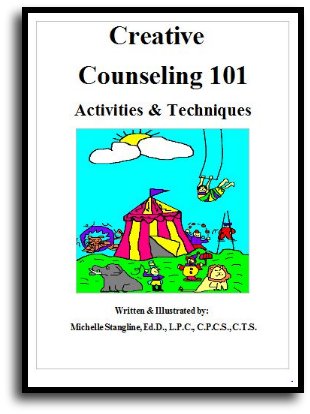
Step By Step Therapy:
Learn how to be a more Creative Therapist with the Book that started it all!
- Graduate School Counseling book used by hundreds of graduate counseling students!
- Includes full color reproducible worksheets with most activities.
- Winner of the Counselor Writer of the Year Award, 2011, Georgia Regional Award
Download Your Copy Today Only $39.95:
See Creative Counseling 101 eBook Information Here:
Get the Set
of all four
eBooks for only $98.95:
An incredible collection of how to do therapy eBooks!
A $159.80 Value,
You Save Over $60!
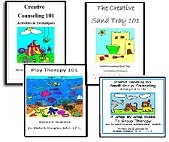
Get your complete set of the Creative Counseling 101.com eBooks by Dr. Michelle Stangline for only $98.95, that's less than $25.00 per eBook (Regular Price is $39.95 for each eBook.).
Your complete set includes:
- Creative Counseling 101
- Creative Group Counseling 101
- Creative Play Therapy 101
- Creative Sand Tray 101
For more information click the link below:
See Complete Set of eBooks For Sale Here:
New!!! "Beyond Art Therapy" 101 eBook
Over 300 pages of Beyond Art Therapy activities and techniques. Learn what I teach graduate counseling students!
See the link below for more information.
Only $39.95
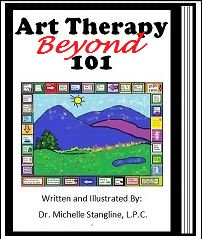
See More Invividual eBooks For Sale:
Sand Tray Therapy 101 eBook:
Learn how to do Sand Tray Therapy or enhance your skills.
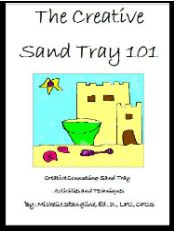
Play Therapy 101 eBook
Learn how to do play therapy or enhance your skills.
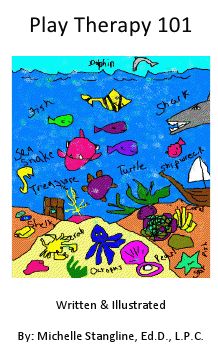
Small Group Counseling eBook For Sale:
Learn how to do creative group therapy and enhance your skills.
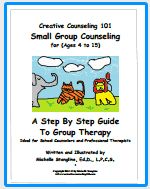
School Counselor Guidance Lesson & Social Stories eBook for sale:
Get a year's worth of school counselor guidance lessons with "Creative Warm & Fuzzy Classroom Guidance Lessons eBook". Introduce your students to the "Warm & Fuzzy Way". Click the link below for more information:
Warm & Fuzzy School Counselor Guidance Lessons eBook
